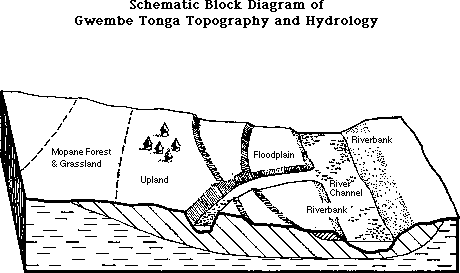
The following graphic illustrates the general agricultural dynamic of the Gwembe Tonga. There are three types of fields:
Upland fields must be fallowed after about 5 years of cultivation in order to recover their fertility. In order to survive the full annual cycle, an individual must have access to Upland and Floodplain fields, and should have at least one Riverbank field to fall back on for vegetables in the hot dry season. Grain is the staple food, and although it is supplemented with meats, vegetables, and wild plant foods, insufficient grain harvests will seriously affect the viability of any family. The trick to surviving as a subsistence farmer is balancing the food requirements of your labor pool, the amount of productive land available to you, and the labor necessary to take advantage of the productive potential of the land.

|
|
|
|